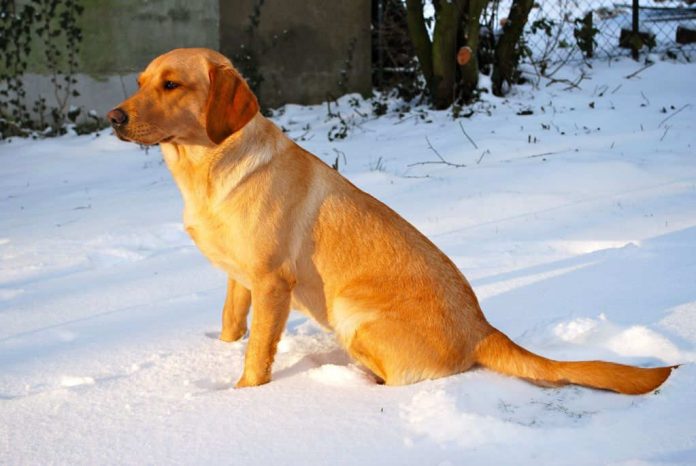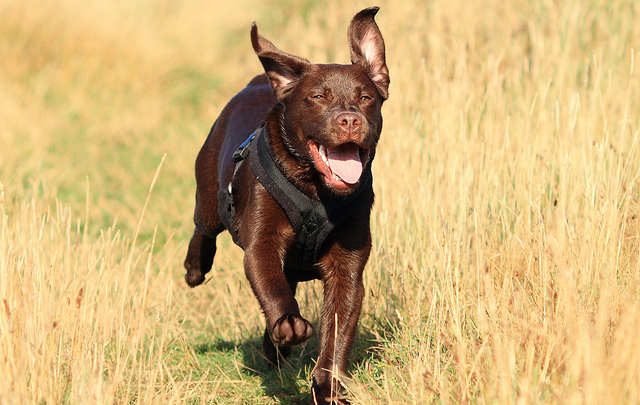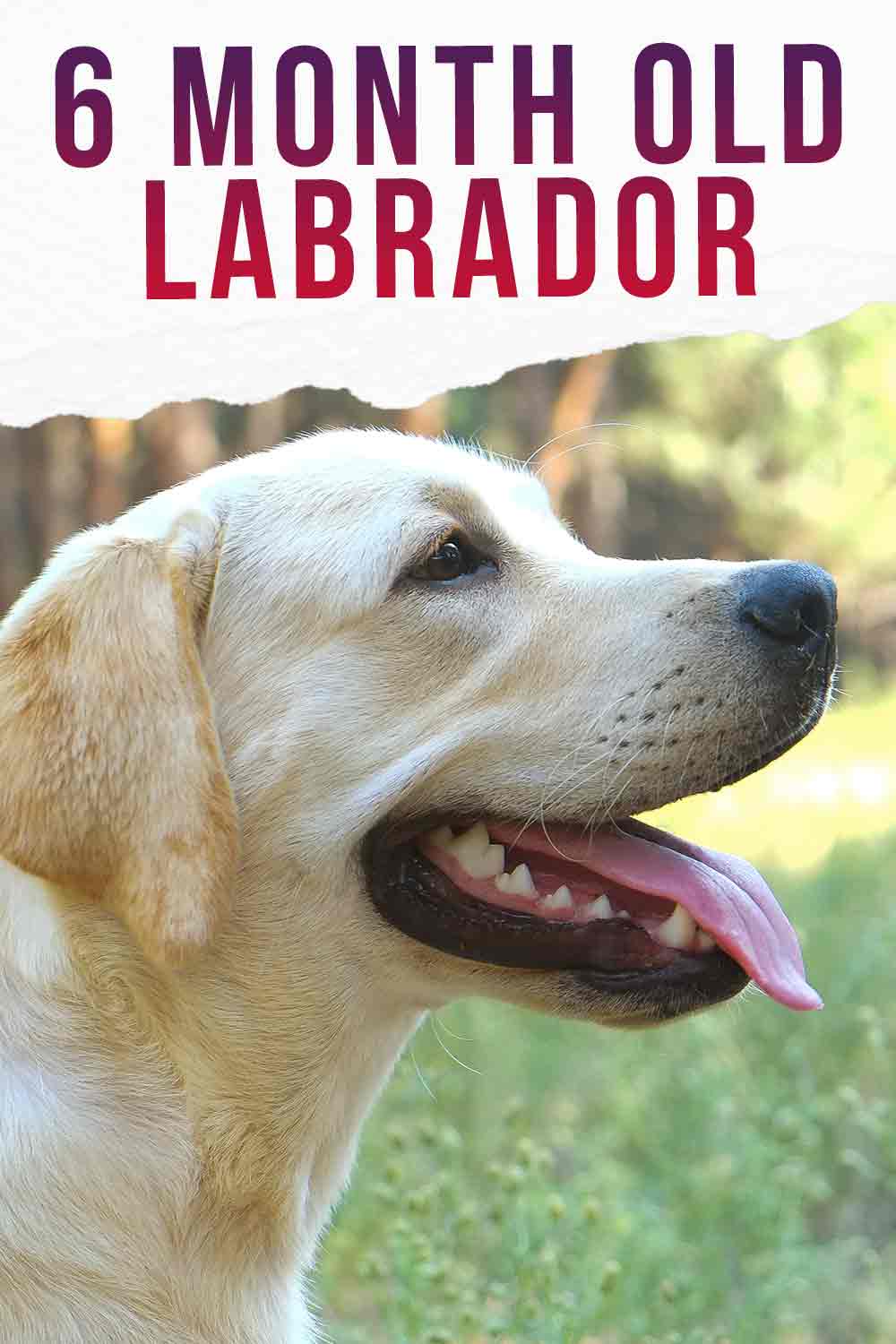
Your 6 month old Lab has nearly reached their adult height, but they are still scrawny. All legs and giant feet, often with disproportionately large ears. They are an established part of the family, but with those teenage hormones and the confidence of being settled in the home, they can also be a bit of a nightmare to manage. Chewing, biting, pulling on the leash. We’ve seen it all, and if you’re just entering this high octane period in your dog’s life you’ll probably have a lot of questions. We are going to help you to live happily alongside your 6 month old Labrador. We’ll do that by letting you know what it’s fair to expect from a 6 month old Lab, and what they won’t be ready for yet. You will find out how they should look, what size they ought to be and what to aim for in their training.
People often want to know what is ‘average’ or normal for a six month old Lab puppy, so we’ll be looking at some of your questions. Such as:
- How much does a six month old Labrador puppy weigh?
- Is a 6 month puppy finished teething?
- What should I feed my six month old pup?
- How can I train my 6 month old Labrador?
- 6 month old Lab exercise
- What commands should my six month puppy know?
And much more! We’ll also be looking at some common six month old puppy problems. I have raised a lot of Labrador puppies, and it’s no surprise that six months old is a really tough stage for a lot of busy families.
It seems amazing that the little fluff ball you bought home just four months ago should be so big. And bouncy! I’m not crazy about quoting ‘average’ weights because there is so much variation between healthy Labradors of exactly the same age. But I know you want an answer, so as a very rough guide, many 6 month old lab puppies will weigh around 50lbs. That’s usually at least double what he weighed four months ago, and this very rapid period of growth in his lifetime is now at an end. The remainder of his growth, another 10-20lbs or so will take place more slowly over the next 6 months.
People often ask if there is any difference between the different colors with regard to weight and size. The answer is kind of. It isn’t so much a color connection as a type connection.
Working type (American or field bred) Labradors are often lighter at six months than show type (English or bench bred) Labradors. And in the UK at least, most field bred Labradors are either black (the majority) or yellow (including fox red).
Most (not all, but most) chocolate Labs in the UK are show or pet bred Labradors and tend to be more heavily built. So your chocolate puppy might well be heavier at six months than your friend’s black puppy. And your fox red puppy might well be lighter than your friend’s show bred (cream coloured) yellow pup. Of course, these are all generalisations and you’ll find a whole range of weights in each color if you look hard enough.
Although he might not easily fit in your lap any more, at six months your Labrador puppy will still look a little ‘puppyish’. There is a softness to his features that will last another couple of months or so. Some 6 month old Lab puppies are a little ‘gangly’ but as you can see from our photos, many are now quite adult in proportions, a slightly smaller version in fact, of their grown up selves.
How much food your puppy needs will depend on how much he weighs and what condition he is in. Have a look at our puppy feeding chart and also at the instructions on the packet of food that you are using. If your puppy is a little on the skinny side give him a tiny bit more food than recommended and if he is looking a bit plump, a little bit less.
Remember that it isn’t what your puppy eats today, it’s what he eats over the course of a week that really matters. Consistent overfeeding will make a puppy fat. Consistent underfeeding will see him lose weight.
Your 6 month old Lab can drop down from three meals a day to two without any problems. This means that you will be giving the same amount of food as before, but in two larger meals instead of three smaller ones.
Be aware that this can upset some dog’s tummies. So, if your pup gets diarrhoea when you switch to twice daily feed, skip a meal to let his tummy settle, then go back to three meals a day for a few days. When you next try going down to two meals a day, give him two small meals to begin with and increase the meal size gradually over the next few days
If you’ve been keeping to the ‘five minute rule’ you may be wondering if you can slacken off on this now, and take your Labrador jogging. If you are not familiar with it, the five minute rule says that a puppy needs five minutes of exercise per day for each month of his life.

Most experts would divide that into two sessions. So that’s a total of thirty minutes a day at six months old (fifteen minutes in the morning and fifteen minutes in the evening). This refers to formal walks, not playing in the garden or messing about with other dogs.
The truth is, we don’t have much evidence on the effect of exercise on puppies over six months old, but my personal view is that it still pays to be cautious. And the reason for that caution is that your puppy is still growing and the growth plates in his joints are still vulnerable to damage. So my advice would be to avoid hard exercise until your puppy is well past his first birthday and then to build up gradually over a period of several weeks.
Puppies become sexually mature before they are physically mature and long before they are mentally adults. Some six month old puppies are capable of breeding. And definitely should not be allowed to do so.
Apart from the ethical and moral implications, it may be physically harmful to breed from such a young female.
Many female Labradors will have their first season sometime between six months and a year, so this is something you need to be looking out for.
Some of you will have already had your 6 month pup neutered, others will be thinking about doing so in the next few months. It is a good idea to read up on the pros and cons of neutering before you go ahead as recent evidence shows that it isn’t as clear cut a decision as was once thought.
If you decide against neutering, this is a good point in time to review the security on your property and make sure it is thoroughly dog proof. Labradors are surprisingly agile and can often jump higher, and dig deeper, than you imagine.

Once sexually mature, many a Labrador, particularly (but not only) males, will make more effort to explore beyond the boundaries of your property. And if you have a female in season, other enterprising males will do their best to find a way in!
Whatever your intentions, the time for breeding is a long way off right now. Bear in mind your dog is nowhere near grown up. In many ways he is still a baby. Which brings to on to other ‘baby’ matters.
Most puppies have shed the last of their baby teeth by six months of age. And will have cut many of their adult teeth by this point too. Most will have all their adult teeth within the next month or so.
At six months, many young Labradors are on the verge of a big surge in ‘independence’. This is the point at which most young dogs start to lose their fear of losing you. This has some big implications for those that exercise their young dogs off leash in open country, where there are temptations such as wild birds and animals to chase. So if you haven’t done much in the way of training yet, there is no time like the present. Which brings us to the next question.

As a trainer of working retrievers I can tell you that I have had six month old Labradors that were quite advanced with their training and others that had barely started. All reached the same standard eventually. So don’t panic if you haven’t done much yet in the way of training. However, it is important to get started with training now.
Six or seven months is often the age that people realise they need to do something about their Labrador’s behavior, simply because he is getting so big. And while there is no set standard your puppy should have reached, it is definitely time to get some safety cues installed. I’ll explain below.
Most six month old pups have only quite basic obedience and are not yet reliably obedient when there are lots of distractions about. While many six month olds will sit when asked, and come when called in the house and yard.
Outdoors at the dog park, on the beach or in the countryside, it’s a bit of a different story. And a lot (the majority) of six month old Labradors are still pulling on the lead. Professional or serious hobby trainers aside, this is fairly normal.
The two commands you should really focus on now are what I call the ‘safety cues’ And that is ‘come’ and ‘heel’. Most importantly, you need to focus on proofing these cues against distraction. I’ll explain that too.
The come cue, or recall, is important so that your dog can be allowed safely off leash and recalled if any hazards appear. You can find information on teaching recall here:
Even if you have made quite good progress with recall, now is quite a good point at which to be thinking about the about turn walk this is a technique to prevent your dog from getting too far away from you on walks.
The ‘heel’ cue is important because until your Labrador can walk nicely on a loose lead, he is a danger to both himself and to you. This is especially important as he grows bigger. Labradors are strong and often friendly dogs. This makes pulling on the lead very common as your puppy does his best to engage every passing stranger in a game.

I have seen grown ups pulled clean off their feet by large dogs on leash. Being pulled off your feet, or losing control of your dog at the roadside is a very real risk. So, loose lead walking is a must and you’ll find the information you need here
Many young Labradors are very friendly and while this is a great thing overall, it can cause some problems with training at this age. I mentioned proofing earlier, and proofing is the process which teaches our dogs to come away from other dogs or people.
To walk on a loose lead past your neighbour’s cat, and to sit (rather than jumping up) when visitors arrive. It’s all about following your cues, even when there is something else your dog would rather do. And proofing is the way to succeed.
The main problem with proofing is that it takes time and help. You can’t do it on your own. You’ll need to use my ‘fake it till you make it strategy‘ – it will make sense when you read the link. You might also find proofing Labrador obedience helpful. A good sense of humour and some supportive friends won’t go amiss as you work your way through this tricky stage in training!

Training methods are changing. We are in something of a new era with regard to dog training methods and there are now plenty of good trainers who can show you how to train your dog effectively without fear or pain. If you can’t get to a good positive reinforcement dog training class, you’ll need to follow a good training guide.
Most six month old pups are through the housetraining phase, though there may be very occasional accidents if a your dog is left alone for a lot longer than usual. Female dogs may have an occasional accident during their first season too, but these are usually isolated incidents.
Something a lot of people expect to be over at six months but isn’t, is destructive chewing. If you are expecting chewing to stop at the same time as teething coming to an end, you may be disappointed. We look at destructive chewing in more detail in this article, but it can be at its worst between 6 and 9 months of age. Which brings us to a common question
The six month milestone is a popular time for people to review the whole ‘crate situation’ After all, the puppy is sleeping through the night now, and he is probably clean all day. It seems mean to shut him away at bedtime. Why not give him the freedom of the kitchen during the night?
Well, this can work. But often it does not and results either in a bad chewing problem or occasionally, in a relapse in house training. You can find out more in this article which includes detailed de-crating instructions. The other big issue for many puppy parents with six month olds, is excitable behavior. Particularly jumping up, and sometimes nipping
Jumping up is a common problem in young labs. These are friendly and affectionate dogs who enjoy close contact and like to greet their friends up close! The reason many people don’t discuss this until the six month milestone is simply one of scale.

It isn’t a big deal if a three month old puppy jumps up at you. You and your visitors not only tolerate it, but actually reinforce it by petting the puppy as he does it. It’s often only when he can put his paws on your shoulders that it occurs to you this might not be such a good idea. You need to nip this problem in the bud now, and you’ll find the information you need in this article.
The last issue we’re going to look at is excitement. Or rather over- excitement. This is the age at which excitable behavior can become quite a challenge again. Partly because the dog is now physically bigger, stronger, and more difficult to control. You can’t just pop your six month old under your arm and carry him home. Now, more than ever, you need your dog to listen and respond to your voice.
More often than not, excitable behavior that has got out of control, started out as a game. People say to me “I can’t play with him any more – he just gets too excited” And this is common. It’s more important than ever as your dog grows to learn how to play safely with a big dog. And I think you’ll find that link helpful.
I don’t want to make it sound as though six month old puppies are a nightmare – because they are not. And many puppies won’t have any significant behavioral problems at this age. However, if you are struggling a bit, you are not on your own. Drop into the forum and say hello to all the other puppy parents. It’s often a great comfort to talk around these problems.

Pippa Mattinson is the best selling author of The Happy Puppy Handbook, the Labrador Handbook, Choosing The Perfect Puppy, and Total Recall.
She is also the founder of the Gundog Trust and the Dogsnet Online Training Program
Pippa’s online training courses were launched in 2019 and you can find the latest course dates on the Dogsnet website